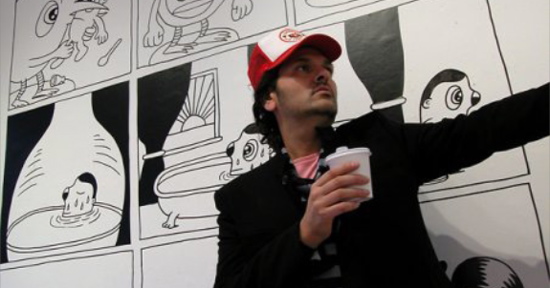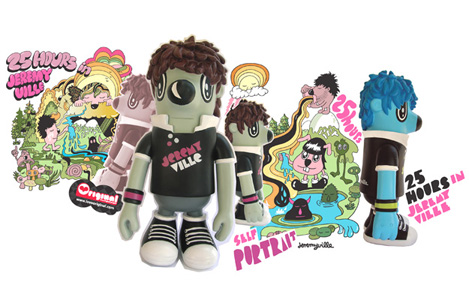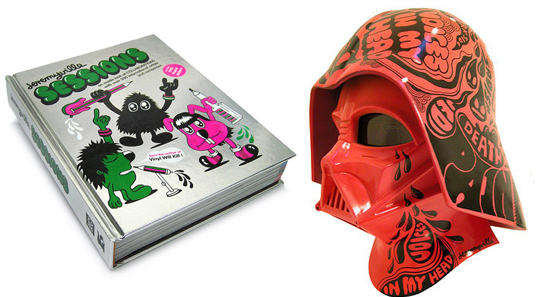SpearTalks: Jeremyville

Jeremy Andrew, a.k.a. Jeremyville, covers a bit more ground than your typical designer-slash-artist. Perhaps we should rephrase that, for while it is correct to refer to what Jeremy covers as "ground" (being that he darts around the world with a fearsome frequency), the bare truth is that what Jeremy really covers is stuff. A ton of it. Television screens, snowboards, books, bags, hundreds upon hundreds of t-shirts; Jeremyville is, in many ways, the king of self-branding. An affinity for creation, done at a somewhat obsessive frequency, has allowed him the opportunity to pair with hundreds of entities.
From Rossignol to MTV, Jeremy's ongoing series of collaborations has resulted in a lineup that would make even the editors of Hypebeast blush. Read on to find out what it is that keeps Jeremyville humming along so steadily.
Joshspear.com: You went to school to become an architect, became a cartoonist rather inadvertently, and then continued on to become "Jeremyville." Was this series of events a result of following your dreams, or something more fate-driven?
Jeremyville: I’d say Jeremyville is the result of a million considered decisions, some erroneous in hindsight, some okay!
Jeremyville has evolved quite a bit; it's now best described as a project-based concept. Any idea or project that interests or excites me, I bring in to the Jeremyville story. A book. A collab. An animation. A t-shirt. A toy. A new character. Anything that adds something to the overall Jeremyville landscape, and that intrigues the viewer.
I mostly call myself Jeremyville these days, as I'm the sum of these parts – these projects are my babies and have so much of me invested in them. I'm proud to be really personal in my work, and universal at the same time. I'm striving for some sort of "˜universal intimacy', by which I mean I want both a kid in Paris and a 60 year old in The Midwest US to get something from my work, like from one of my comic stories. This might sound a bit esoteric, but I really do think about such things daily! And no, I don't read self help books!
JS: You live in a beautiful area. How do you view the relationship between environment and creativity?
J: Sydney is an amazing secret and a creative and cosmopolitan place – I'm near the water, though for the last few months I've been living in New York, which is where my new studio is, on the Bowery, and it's been great to have face time with clients and my agents here. I think definitely New York has affected my creativity; I can't stop drawing and creating here, the recent art history of the place is a huge inspiration for me – especially the revolutionary graffiti days of the early 80's in New York. I feel the residual energy of Haring and Basquiat in the East Village where I am, and their studios were based here, and on the Lower East Side. New York is the best ever.

JS: You fit within the lines of a wide variety of occupations. What have you recently added to the list that you're most excited about?
J: I just held the new production sample of the Converse shoe I designed. It will be out in spring 08 and everyone's really psyched about it. We were in seeing Jason at Converse today – he gave us a whole heap of shoes. Also, doing some cool new secret projects, which are under wraps for now! If I tell you I'll have to eat you.
JS: The publishing of Vinyl Will Kill seems to mark a turning point in your career. How has Jeremyville progressed since then?
J: Thanks, yes, that was a great calling card for Jeremyville overseas. I was in a meeting yesterday with Paul Budnitz, the president of Kidrobot here in New York, and who I had interviewed him for Vinyl Will Kill in 2004. He told me that he's been watching my work grow and develop over the last 3 years, and he asked my why that was, why more than most other artists. I told him it's because I draw every day, and that's really the answer; you need to always push yourself and invent new stuff, try not to stagnate.
I'm happy to say the progression since Vinyl Will Kill has been one of growth with a lot more product crossovers: Snowboard designs for Rossignol; a new book called Jeremyville Sessions also published by IdN; the initiation of sketchel, the customizable art satchel project; collabs with people like Beck, Miss Van, Geoff McFetridge, Genevieve Gauckler, Converse, and Kidrobot; comics published in Swindle magazine; invitations to fly to Milan for the MTV event; Beijing for Tiger Translate; Paris for my show at Artoyz; my NYC show hosted by Thunderdog; and the establishment of our new agents in the US, Japan, UK, and EU.
I want to always push myself. I'm quite hard on myself, but generally I'm a bit lazy, so I need to work at it. I always keep in mind that I want to do much, much more.
JS: Jeremyville is composed of you and a small group of people. What characteristics do you have in common that help make going to work both fun and productive?
J: Neil and Megan are the two other key players in the company. Neil is my business partner, and Megan is my creative partner and creative producer on many projects. Without their work I wouldn't be able to do half of what I do, simply because their expertise in their roles and their responsibilities allow me the time and freedom to concentrate on creating things.

JS: Clients come to Jeremyville bravely, often giving you the reins to take projects wherever you like. How do you think your job/creativity would differ without that freedom?
J: Maybe I'd be a bit more cautious in some creative decisions, but clients seem to trust my judgment a lot, which gives me more freedom to push boundaries and challenge both myself and the client's perceptions – which is a good thing.
JS: Tell us about your experience working for MTV…
J: They flew me over for the 10 year anniversary of MTV Italy, and we each painted large MTV toys at the massive Milan Fair, and stayed in the MTV House with Simone Legno from Tokidoki, Tado, Rinzen, Furi Furi, Mauro Gatti, Yo Clas, it was a blast!!! FUN TIMES!! We ate Italian cheeses, drank Peroni beer and sampled prosciutto and 30 year old port in local restaurants at 3am, while the Italian media interviewed us for a week, all culminating in this massive MTV party for 10,000 people. Not a bad gig. I've also done animation work for MTV Latin America and Australia "“ and I'll be doing stuff for other MTV networks soon.
JS: You've designed over 500 tee shirts, correct? What is it about tees that you love so much?
J: I love vintage tees, I always try and imagine my designs in some vintage store 20 years from now, and some kid picks it up and thinks, wow, sooo 2008!! I try to be of the era I'm in, not try to rehash, say, an 80's style. I do my own thing, which hopefully taps into the zeitgeist of the graphic iconography of the late 2000's.
I was in the Apple store in Soho NYC today, and it's like walking into some soon-to-be museum of technology. All the really up to the minute software and computers right now will be antiques in 10 years time and will hold such nostalgia, but right now they're the hottest items around, and they have captured the zeitgeist. Same with tees; I see them in that same "time capsule" way.
JS: Do you still make time for personal projects?
J: I feel like all my stuff represents one long personal project – everything I do I'm really proud of. I add it to my blog and it's all a part of me. Also, drawing each night is a daily personal project. So too is writing my comic stories, silent square frames with a visual narrative.
JS: Just a few years ago, urban culture was already hyped, yet today it's even more so. What messages in this culture are you concerned will slip through the cracks as the movement grows?
All of the great but unknown artists out there. I want the world to know about all of these great artists I love, but who have not really been heard of outside the industry.
JS: Do you have a Jeremyville wishlist of what you'd like to do in the next ten years?
J: Always try to grow, and never stagnate creatively. If I do that, then any project will be interesting to me, and hopefully to my audience. I want to take my audience on a great journey with me over the next ten years, and excite them and challenge them along the way. If I can do that, it will make me very happy indeed.

